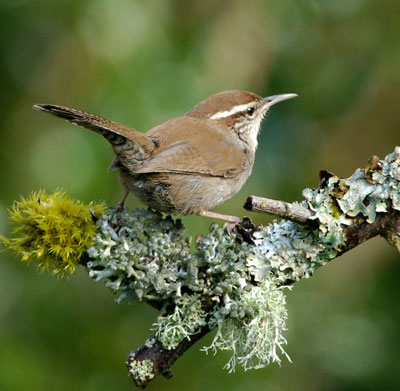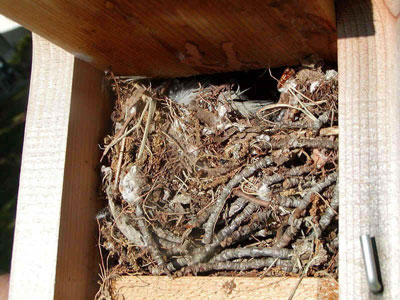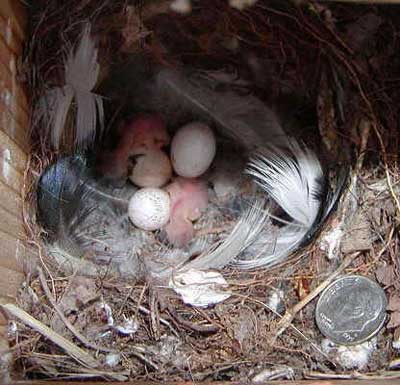|
|
Also see Nest ID Matrix (contents) and Egg ID Matrix (color, spots, etc.)
To see other cavity nester bios/photos:
Also see chart to help ID nests by construction material.
 Bewick’s Wren. See info on biology and nesting habits. Note eye stripe. Photo by Minette Layne. On Wikimedia Commons. Click on photo for larger image. Bewick’s Wren. See info on biology and nesting habits. Note eye stripe. Photo by Minette Layne. On Wikimedia Commons. Click on photo for larger image.
Be careful not to confuse with Carolina Wren or House Wren. If you remove House Wren dummy nests, and Bewick’s Wrens are found in your area, make SURE it is a House Wren nest before removing it! Bewick’s Wren populations have declined alarmingly in many areas. |
||
 Bewick’s Wren nest. Photo by Shelly Harris of Oklahoma. Bewick’s Wren nest. Photo by Shelly Harris of Oklahoma.
Nest Description: Bulky nest (sometimes domed) with a deep cup of grass, feathers, hair, plant down, moss and dead leaves on a base of short twigs/sticks, rootlets, chips/leaf debris, spider egg cases, oak catkins. May have a wider variety of material in the base, with finer materials in the cup. Often snakeskin or cellophane in cup, which is deep and tiny and may be in a back corner. May be a little more “organized” looking than a Carolina Wren nest. Typically do not fill up tall large cavities to the top like a House Wren. |
||
 Bewick’s Wren nest, with eggs hatching. Photo by Shelly Harris. Bewick’s Wren nest, with eggs hatching. Photo by Shelly Harris.
Eggs are oval or rounded oval, white with irregular brown, reddish brown, purple or gray spots/dots often concentrated in a ring on the larger end. Some eggs in a clutch may have more pigmentation than others. Smooth with little or no gloss, unlike House Wren. Egg size increases with egg order, and the last eggs are the largest. |
||
 |
The student of Nature wonders the more and is astonished the less, the more conversant he becomes with her operations; but of all the perennial miracles she offers to his inspection, perhaps the most worthy of admiration is the development of a plant or of an animal from its embryo.
-Thomas Henry Huxley, British biologist and educator. Reflection #54, Aphorisms and Reflections, selected by Henrietta A. Huxley, Macmillan, 1907.
